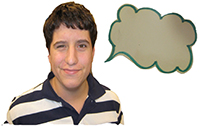by Debi Swedelson Mishael
 Many years ago, as I was reading a copy of Reader’s Digest I saw the “Potent Quotable” section and a light bulb went off. How many times have I been teaching a lesson and a student blurts out a pearl? What would happen if I used my students as the source of a classroom Potent Quotable Wall? This simple idea would forever fundamentally change the way students responded to discussions in my class. More importantly, it gave me the opportunity to recognize my students in a meaningful way for meaningful contributions.
Many years ago, as I was reading a copy of Reader’s Digest I saw the “Potent Quotable” section and a light bulb went off. How many times have I been teaching a lesson and a student blurts out a pearl? What would happen if I used my students as the source of a classroom Potent Quotable Wall? This simple idea would forever fundamentally change the way students responded to discussions in my class. More importantly, it gave me the opportunity to recognize my students in a meaningful way for meaningful contributions.
Imagine Ben sitting in the back of the classroom. He’s not disturbing anyone but he is barely paying attention and I think it’s possible he might even be dozing off. In the front of the room we are looking at a wall map and showing how Israel was invaded on all sides by Egypt, Jordan, Syria, Lebanon and Iraq in what would become the War of Independence. I hear a quiet mumble from the back. “phuhhh, how is that possible?” “Stop! say that again Ben?” I said. Suddenly, as if he thought he was in trouble, Ben’s head shot up. “What? What’d I say?” I asked him again to repeat his last comment. He had to think back because in his mind, he was only muttering to himself. “How is that possible?” he said tentatively. “Yes” I shouted, “Ben you got it.”
I went on to emphasize that the incredulous comment Ben had uttered is exactly the point of the lesson. How is it possible, in the face of all the obstacles, did Israel become triumphant? I asked Ben to write his comment on one of the 6″ x 4″ blank quote bubbles I keep in a small basket on a window ledge in my classroom. Next week, when Ben entered the classroom, his quote was hanging on the wall next to a picture of him. He smiled and I could see the pride in his eyes. From that day on, Ben was more engaged. He looked for ways to contribute because he knew I was watching too.
Students look for ways to contribute because they like being noticed for real accomplishments. Sometimes we use the quote bubbles when a student has a personal “ah-ha” moment like Josh who said, “Oh, so a Talmud page is like a face-book page where lots of people comment on the same post.” Sometimes we use the quote bubbles to recognize a kind word or deed one student did for another. Many times I ask a student to write down a comment that helped me see a subject in a new way. Whenever a student spurts our something brilliant, witty, insightful… you get my point…I can say, “Write that down! That was amazing.”
Potent Quotables can be used for all ages. Anything that comes “out of the mouth of babes” could be written down for them and shared with their parents later. I used a modification to allows the whole class to contribute when I was teaching a 2nd grade class. I found that my students would often arrive 10 minutes early on Sundays. I laminated a set of “Thought Bubbles” and placed one on a bulletin board next to a picture of each student in the class. When the kids came in the room each week, they saw a question of the week on the top of the bulletin board. They could take the dry erase pens and put their own thoughts in the “bubble” next to their picture. The lamination allowed me to wipe off the answers each week and reuse the bubbles for the next question.
Last week, as a set induction to a lesson on “Rebuke: Intervening to Stop a Wrong[i]“, we played a game I called “Tochecha תוכחה Feud.” It was a take-off on the TV game show, “Family Feud”. One member of each of the two teams came to the front of the class to face off. As I described the context, the first to tag in won the chance to give an answer and gain control of the question for their team. “Name something you might say to a waitress after waiting more than 30 minutes for your food,” I said. Ollie, a student in my class who has difficulty staying on task or remaining in one place for very long, tagged my hand a little too quickly. “Did you know that there are 300 tiles on the ceiling?” he said. My first thought was that Ollie was off topic again. I opened my mouth to “rebuke” Ollie but luckily I closed it a second later as I realize his brilliance. As we would see later in the lesson through text study, the mitzvah of Tochecha תוכחה requires us to rebuke without anger or embarrassment and it should be done at the right time. “You must be very careful not to grow angry when rebuking someone (Marganiso Tava no.10).” The class determined, after comparing Ollie’s comical comment to several Rabbinic Texts, that Ollie found a light-hearted way to rebuke the waitress for allowing her customers to sit for 30 minutes without service. You can be sure that next week, Ollie will walk into class and see his words proudly displayed on our Potent Quotable Wall.
Note: Thought or Speech bubble can easily be downloaded from images on-line and reproduced. You can also go to any teacher supply store and find colorful conversation bubbles or stationary in the shape you need. As I was checking the internet for sources I saw white board shaped like a thought bubble! Guess what’s on its way to my classroom right now!
[i] Torah Aura Productions Instant Lesson—Content of Their Character- Rebuke: Intervening to Stop a Wrong by Ron Isaacs.


